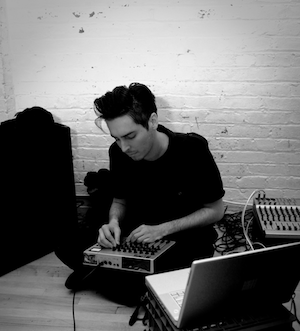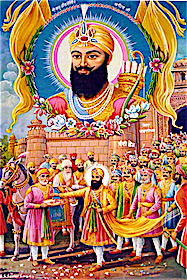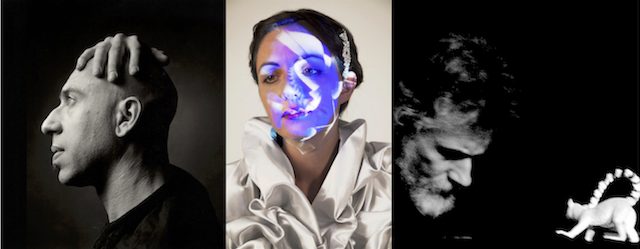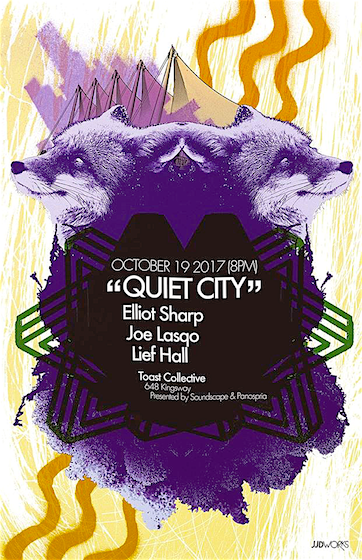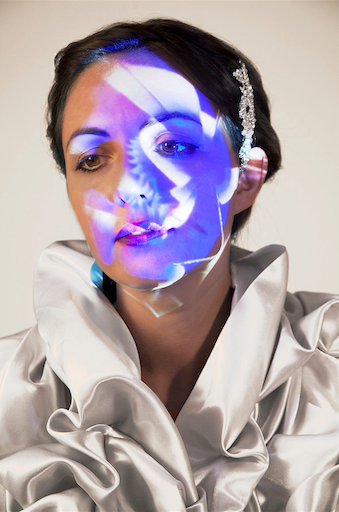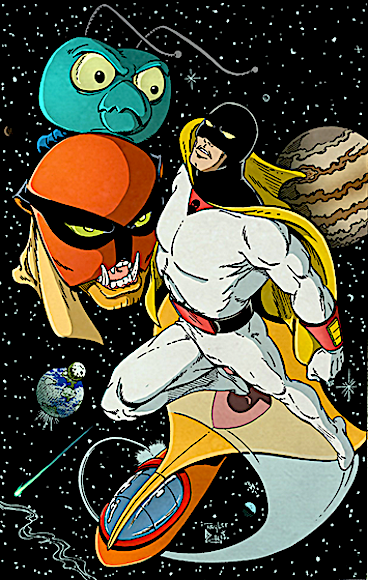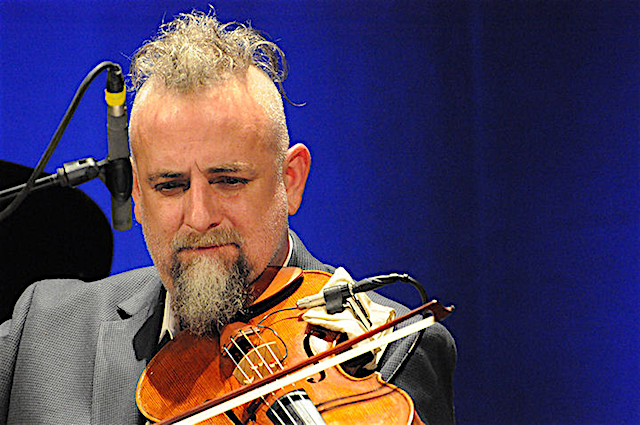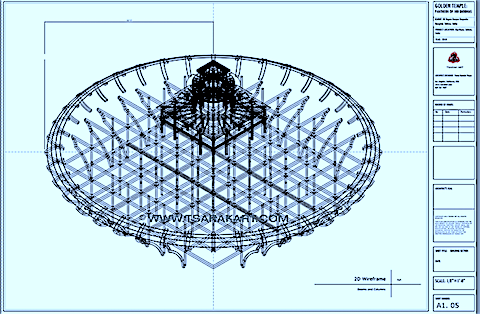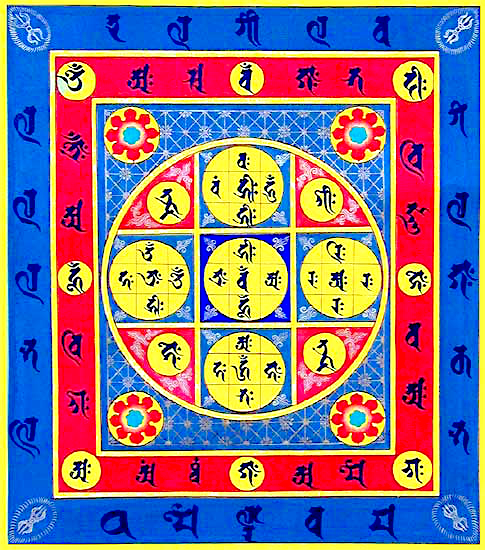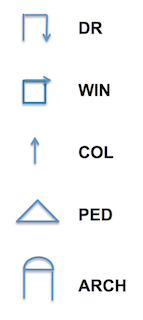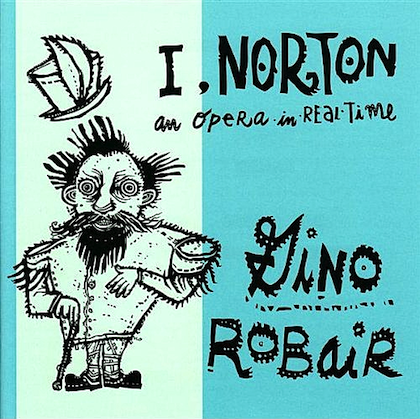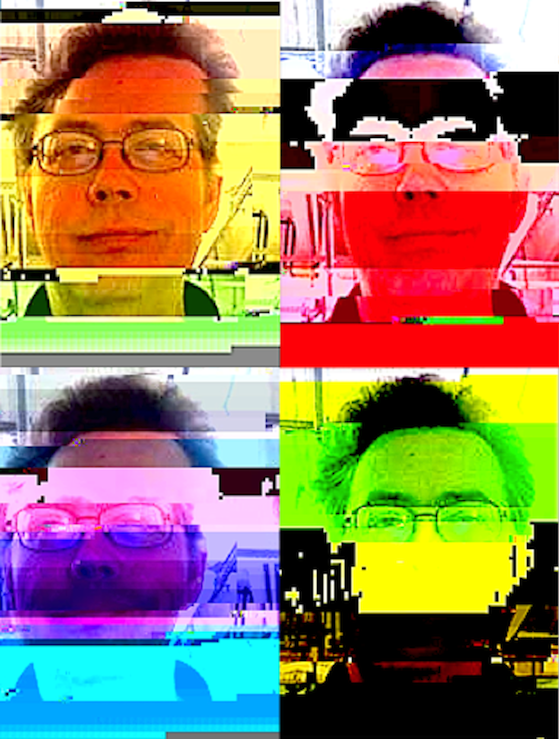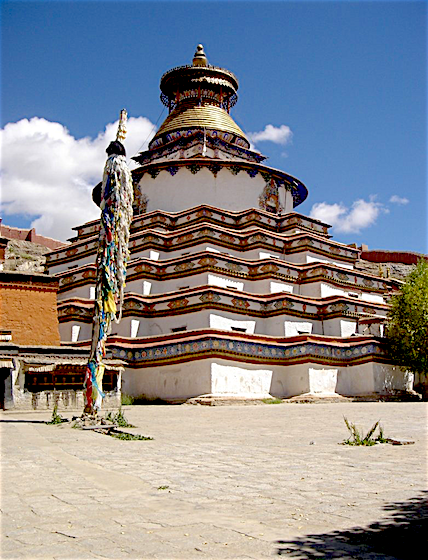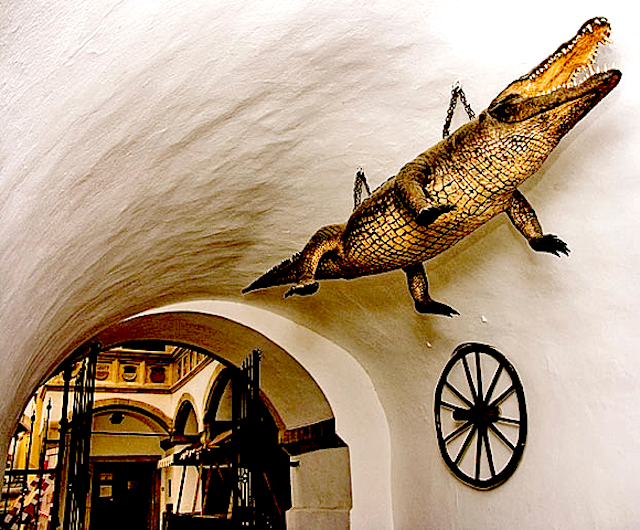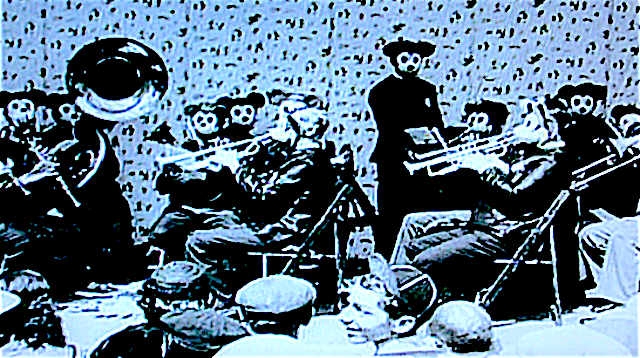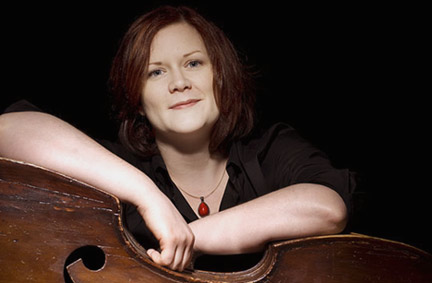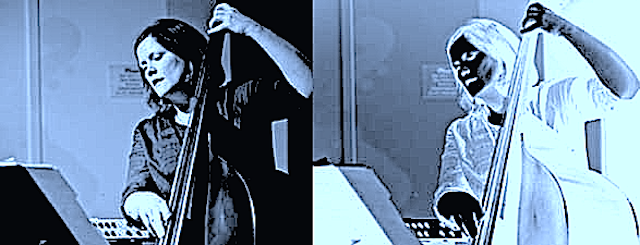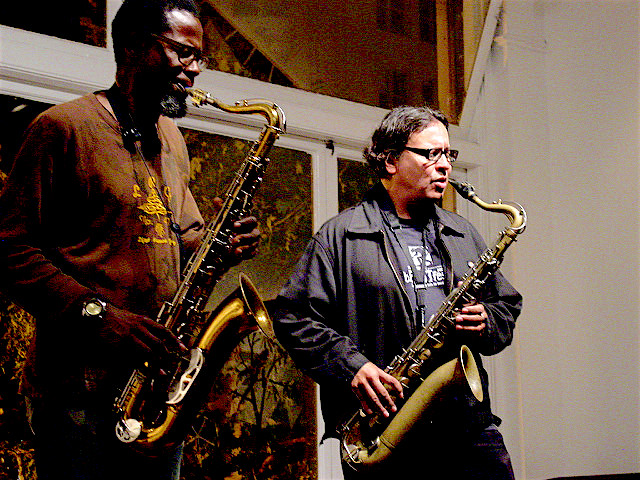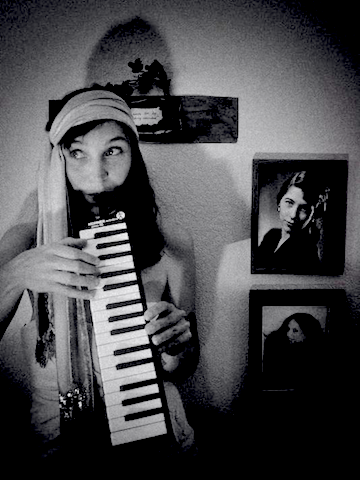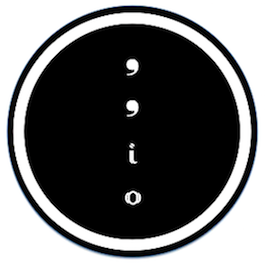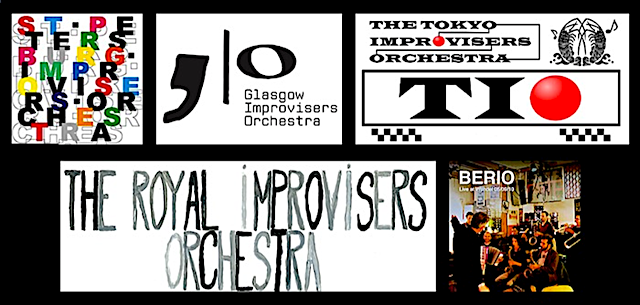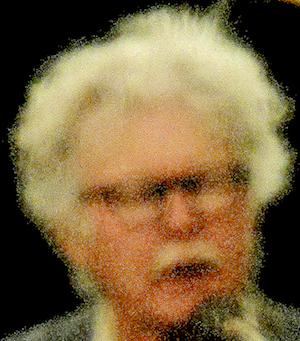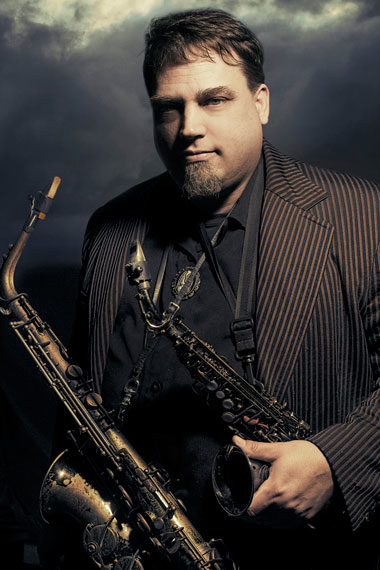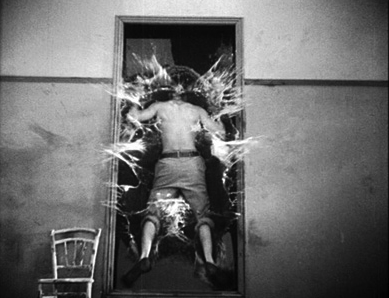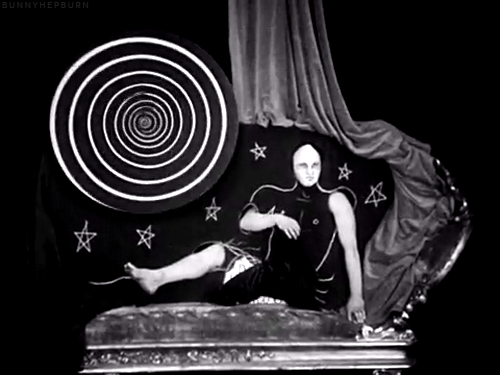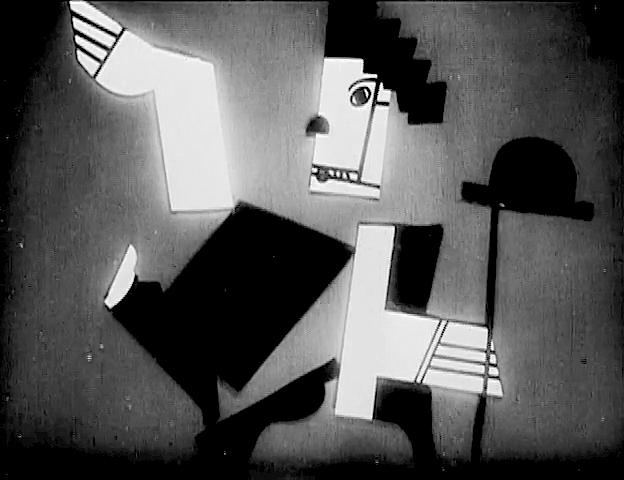
Cocteau — Orphée
Coordinates: The Second Act, SF, 1727 Haight St, SF (between Shrader & Cole – map), 7:30pm, Thu 26 May.
☞ Advance tickets available at a discount: here
☞ Examiner.com review of our 17 Apr performance of this program: here
I’m excited to play again at The Second Act, the terrific performing arts space and restaurant zone that Jack & Betsy Rix, members of the original Red Vic collective, have now created in the Red Vic’s former site — and what better site than this pioneering art film house in San Francisco’s cultural history for silent film + music!
The “Third Wednesday” series run there by James Decker, proprietor/perpetrator of Resipiscent Records, has created a powerful electronic music dipole traversing Haight St., resonating with the Lower Haight’s mutant sound scene @ ROBOTSPEAk.

The Second Act, the next generation of the Haight's Red Vic
The throbbing avant energy unleashed at The Second Act has not only attracted a large and actively engaged audience, but has recently erupted into the visual dimension as well, starting a new film + music series last August with Ben Tinker’s film + music project That Hideous Strength.
I’m excited to again add to this wayang sinema series with new ensemble Fushigi Kenkyūkai (不思議研究会) and some of the freshest, most exciting films ever made.

The founder of the first "Paranormal Research Society" (Fushigi Kenkyūkai : 不思議研究会), in 1886, Enryō Inoue (井上円了)
Since the founding of Clubfoot Orchestra in 1983, San Francisco has been a leader in pairing film classics with composed or improvised scores. Not only is Clubfoot Orchestra still scaling new heights, but a rich new crop of ensembles for film + sound have created a second wave of Bay Area shadow play for the 21st century.
Fushigi Kenkyūkai are a collective of film and sound artists, mixing veterans of Bay Area “wayang sinema” ensembles like Clubfoot Orchestra & Reel Change with pioneers of electronic, computer-based, and invented instruments.
The name Fushigi Kenkyūkai (不思議研究会) means “Paranormal Research Society”. The truth is out there.
The program uses a French surrealist film classic and an experimental American short full of masks and shadows to find it.
Line-up:
Beth Custer (bass & other clarinets | vocals)
Thomas Dimuzio (electronics)
Tom Djll (surrealist prepared trumpet | electronics)
Joe Lasqo (keyboards | laptop | objects)
David Michalak (skatchbox | lap-steel guitar | film curator)
& special guest from Sweden — Biggi Vinkeloe (sax | flute)
Program
Part 1: Short (13 min, with short break for reel change following)
Robert Florey / Slavko Vorkapić: The Life and Death of 9413: a Hollywood Extra
Part 2: Main Feature (95 min)
Jean Cocteau: Orphée
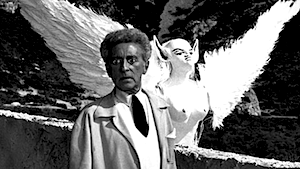
Jean Cocteau and friend

Orphée by Jean Cocteau
◉ Orphée, by Jean Cocteau (95 min)
Continuing from our sonification of Blood Of A Poet (Le sang d’un poète), the first film in Cocteau’s Orphic Trilogy, we move to the second, Orphée, a high peak of post-WW2 cinema.
As Cocteau said of Orphée: “Le sang d’un poète was based on the poet’s need to go through a series of deaths and to be reborn in a shape closer to his real being. There, the theme was played with one finger… in Orphée, I have orchestrated the theme”.

Jean Marais stars as Cocteau's Orphée
The repeated multi-perspective “cubist” deaths and rebirths of Blood Of A Poet are now interwoven into the grand dialog of death with song encoded in the Orpheus archetype.
As Roger Ebert summarizes, “Orpheus is a Greek myth about a musician who descends into the underworld to reclaim his dead wife, and so enchants the gods with the music of his lyre that they permit her to return to the land of the living–on the condition that he never look at her. Jean Cocteau set his 1949 film of the story in modern-day Paris, and added twists that would have startled the Greeks, especially a romantic triangle with Death as the third partner…
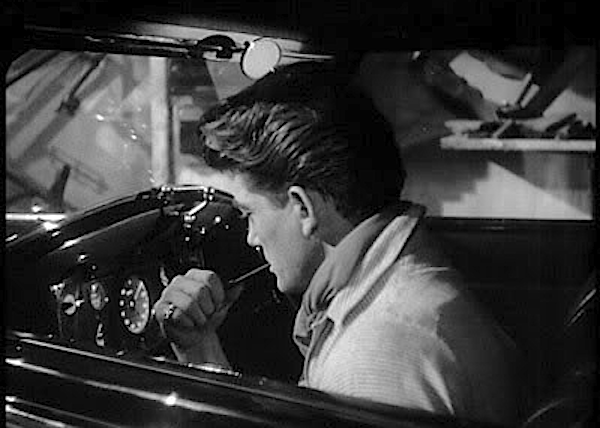
Orphée listens to the number stations of the Underworld on the car radio of Death's Rolls-Royce for poetic inspiration
The story in Cocteau’s hands becomes unexpectedly complex; we see that it is not simply about love, death and jealousy, but also about how art can seduce the artist away from ordinary human concerns, so that after Orpheus astonishingly returns from the land of death, he is more concerned with the nonsensical radio transmissions [from Death’s car radio] than with his wife who loves him.”.

Orphée glimpses Eurydice in the rear-view mirror
The resonant symbolism of mirrors established by Cocteau in Blood Of A Poet is further extended in this second installment of the trilogy, a symbolism deeply intertwined with mortality (Cocteau: “Mirrors are the doors through which death comes and goes. Look at yourself in a mirror all your life and you’ll see death do its work.”)

Underworld bikers as Angels of Death in Cocteau's Orphée
As Adam Scovell says, “Mirrors become liquid gateways to the underworld where the dead work for bureaucrats and live in a disheveled and battered place, while angels of death take the form of two mysterious bikers.”.
Shortly after the film opens a Dark Princess makes a dramatic entrance at the Café des Poètes, with her kept poet, Cègeste, in train. “Do you know who I am?” the Princess asks Cègeste. “I am your death.” Drunk, Cègeste soon becomes disorderly; when the cops arrive he tries to flee, but is then run down by two bikers.
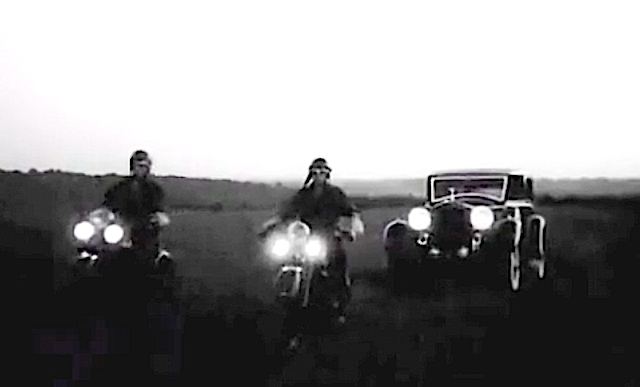
The jouney to the Underworld in Cocteau's Orphée
The Princess bundles Orphée into her Rolls-Royce to help her “take Cègeste to the hospital”, but it soon becomes clear their destination lies elsewhere as they traverse a negative landscape, accompanied by the two bikers as dada poetry comes over the car radio.

Death, The Poet, and biker angels in the underworld, in Cocteau's Orphée
This first shamanic visit to the Underworld gives Orphée two unusual gifts — an addiction to the poison nectar of the car radio’s dada poetry for his inspiration and a practical knowledge of the Underworld which is useful in his quest to redeem his wife Eurydice’s soul when she dies shortly after his return.

Death hovers over Eurydice in Cocteau's Orphée
Though Orphée is able to bring back Eurydice from the Underworld on the condition that he never gaze on her, his increasing attraction to the Dark Princess and his growing addiction to the dada poetry coming from the car radio in her Rolls (which she keeps conveniently parked in his garage…) weave the threads of Eurydice’s ultimate undoing. Reduced to visiting Orphée in the back seat of the Rolls in the garage where he is continuously listening to the meaningless words, her eyes catch Orphée’s in the rear-view mirror,and all is lost… or is it?

María Casares, who played the Dark Princess in Cocteau's Orphée, painting by Leonor Fini (1955) 520v 1.0
A tumultuous series of final plot twists then leaves everyone oblivious or exhausted. As the Princess, turning to her chauffeur, sums up, “If this were our former world, I’d say, ‘Let’s have a drink.'”
———
◉ The Life and Death of 9413: a Hollywood Extra, by Robert Florey & Slavko Vorkapić (13 min, followed by reel change…)

Frame from The Life and Death of 9413 - A Hollywood Extra, by Robert Florey and Slavko Vorkapić
A film miracle that was made in in 1928 for $96 (almost $1,350 in today’s dollars), the nothing budget forced the film-makers into radical effects experiments based on shadow-puppetry and popsicle sticks. “The sets were made of toys and cardboard buildings that were projected like shadows. Paper cut outs and spare film stock litter the background to create a thriving metropolis” (Nathanael Hood)
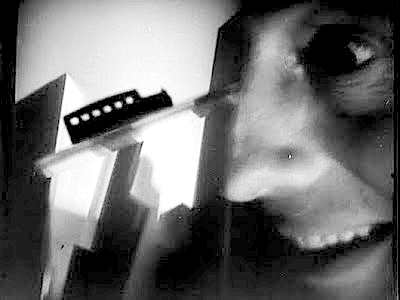
Jules Raucourt plays the actor in The Life and Death of 9413 - A Hollywood Extra, by Robert Florey and Slavko Vorkapić
An aspiring actor with stars in his eyes comes to Hollywood for a meeting with the Producer, Mr. Almighty, who brushes aside his letter of introduction to scrawl the number 9413 on his forehead.

The hapless transformation of the actor into 9413 in The Life and Death of 9413 - A Hollywood Extra, by Robert Florey and Slavko Vorkapić
9413 learns what it really take to be a star from observing the meteoric rise of #15, who attains fame and fortune by donning a series of plastic masks and blabbering gibberish instead of lines.
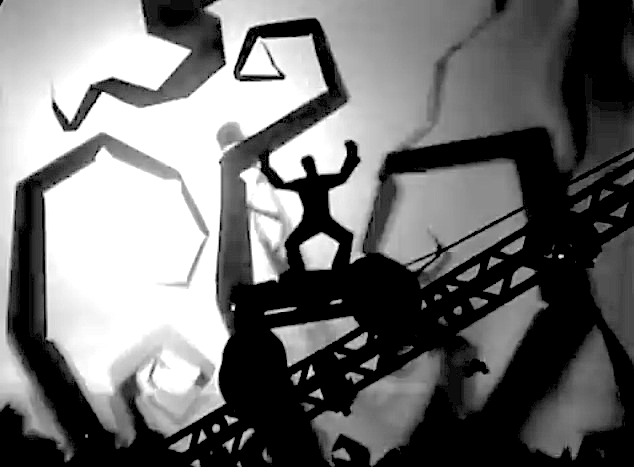
9413 rages against the machine in The Life and Death of 9413 - A Hollywood Extra, by Robert Florey and Slavko Vorkapić
Nonetheless — after being beaten, bruised, and indeed killed by Hollywood, 9413’s spirit gets a vindication of sorts.
———
Carrying on the traditions of and sharing members with “wayang sinema” ensembles like Clubfoot Orchestra & Reel Change, Fushigi Kenkyūkai (不思議研究会) is comprised of:

Beth Custer (Photo - Anne Hamersky)
◉ Beth Custer (bass & other clarinets | vocals) is a San Francisco based composer, clarinetist, vocalist, bandleader, and the proprietor of BC Records.
An original member of the Club Foot Orchestra, a trailblazing ensemble who pioneered scoring and performing with silent films (Pandora’s Box, Sherlock Jr., Metropolis, etc.), Beth is also a founding member of the 4th-world ensemble Trance Mission, the trip-hop duo Eighty Mile Beach, and leads the quartet of esteemed jazz clarinetists Clarinet Thing, as well as The Beth Custer Ensemble. The Pacific Film Archive commissioned Beth to compose a live score for My Grandmother / ჩემი ბებია / Моя Бабушка, a rare Soviet film, which she toured internationally in Russia, Czech Republic, Ireland, and England, supported by Trust for Mutual Understanding and Mid Atlantic Arts Fund awards.
She composes for theatre, film, dance, television, installations and the concert stage and has created scores for the contemporary chamber ensembles Left Coast Chamber Ensemble, Zeitgeist, Earplay, City Winds, + Turtle Island and Kronos String Quartets; for the theatre productions of Campo Santo Theatre, Berkeley and San Diego Repertory Theatre, Magic Theatre, California Shakespeare, Overtone Industries, A Traveling Jewish Theatre, and Cornerstone Theatre; for dancers and troupes Joe Goode Performance Group, Flyaway Productions, Osseus Labyrinth, AXIS Dance Company, and butō (舞踏) masters Harupin Ha (ハルピン派), Koichi Tamano (玉野黄市) and Ledoh (レドー). Her score for JGPG’s The Maverick Strain, which won an Isadora Duncan Award, excerpts enjoyed a run at the Joyce Theater in NYC during April ’09.
Beth has performed and recorded with a diverse array of artists including inventor Trimpin; artists Vladimir Kokolia and Billie Grace Lynn; musicians Stephen Kent, Fred Frith, Miya Masaoka (正岡みや), Joan Jeanrenaud, Amy Denio, Tin Hat, Tango № 9, Pamela Z, Will Bernard, Sex Mob, John Schott, Grassy Knoll, ROVA Saxophone Quartet, Violent Femmes, J.A. Deane, the late, great Snakefinger, Greg Goodman, William Cepeda, Elaine Buckholtz, Mark Eitzel, Penelope Houston, Anna Homler, Ollin, and Connie Champagne.
She has over 35 recordings out with her ensembles Eighty Mile Beach, Clarinet Thing, Trance Mission, The Beth Custer Ensemble and Club Foot Orchestra.

Beth Custer performs "For the Grace of Any Man" at the Red House Speak Easy, San Francisco, June 2012
Beth created KQED’s Independent View theme with her band Eighty Mile Beach and composed for CBS/Film Roman’s Twisted Tales of Felix the Cat with Club Foot Orchestra, as well as creating music for the films of Cathy Lee Crane, Melinda Stone, Betsy Bayha, Julie Wyman, George Spies, Karina Epperlein, Will Zavala, Peter MacCandless, and Koohan Paik (박구한). Beth created four musicals with award winning writer Octavio Solis in LA & SF, and her collaborative scores with inventor and MacArthur Fellow Trimpin led her to compose Vinculum Symphony, a site-specific, large-scale work that unites chamber musicians with experimental instrument builders.

Stephen Kent and Beth Custer perform in the Sanctuary of Dawn at the Garden of Memory event, Chapel of the Chimes, Oakland, 21 Jun 2012
Beth has performed and recorded with a diverse array of artists including inventor Trimpin; artists Vladimir Kokolia and Billie Grace Lynn; musicians Stephen Kent, Fred Frith, Miya Masaoka (正岡みや), Joan Jeanrenaud, Amy Denio, Tin Hat, Tango № 9, Pamela Z, Will Bernard, Sex Mob, John Schott, Grassy Knoll, ROVA Saxophone Quartet, Violent Femmes, J.A. Deane, the late, great Snakefinger, Greg Goodman, William Cepeda, Elaine Buckholtz, Mark Eitzel, Penelope Houston, Anna Homler, Ollin, and Connie Champagne.
She has over 35 recordings out with her ensembles Eighty Mile Beach, Clarinet Thing, Trance Mission, The Beth Custer Ensemble and Club Foot Orchestra.

Thomas Dimuzio
◉ Thomas Dimuzio (electronics)
Thomas Dimuzio is a composer, multi-instrumentalist & electronic musician, mastering engineer, sound designer, and label proprietor based in San Francisco.
Long regarded as a musical pioneer for his innovative use of live sampling and looping techniques to create compelling works, Thomas is a true sonic alchemist who can seemingly create music events out of almost anything. Listed sound sources on his various CDs include everything from ‘modified 10 speed bicycle’ and ‘resonating water pipe’ to short-wave radios, loops, feedback, samplers, and even normal instruments such as clarinet and trumpet, while his current work is facilitated by the deep expanses of modular synthesis.
His use of signal processing, custom crossfade looping, and algorithmic mixing fuels a synergy of man and machine in his live performances, while intercepted signal feeds from collaborators, wild sources of MIDI-controlled feedback, modular synthesizers, circuit-bent toys, or ambient microphones on the streets, become integrated as sound sources within his system of live interactive electronics, effortlessly moving from electroacoustic and noise to glitch, dark ambient, improv and drone.

Thomas Dimuzio
In his work as a sound designer, Thomas has worked with synthesizer and processor manufacturers such as Kurzweil, Lexicon, and OSC to create custom presets and sample libraries, and he has collaborated with Fred Frith, Tom Cora, and ROVA Saxophone Quartet to create sound libraries for Rarefaction and Big Fish Audio. Thomas also continues to play a key role in the development of Avid’s industry standard Pro Tools HD recording and mixing system, as he has for the past 20 years.
As a collaborator, Thomas works with numerous artists and ensembles such as Dimmer (with Joseph Hammer), Chris Cutler, Fred Frith, Dan Burke/Illusion of Safety, Nick Didkovsky, ISIS, Negativland, Arcane Device (David Lee Myers), Matmos, Wobbly (Jon Leidecker), Poptastic, 5uu’s, Tom Cora, Mickey Hart, Paul Haslinger, Arte Saxophone Quartett, Due Process, and Voice Of Eye.

Thomas Dimuzio
As a mastering engineer, Thomas has worked with independent artists and labels through his own Gench Studios since the early 1990’s. Among his clients are Matmos,Negativland, ISIS, AMM, Captain Ahab, Doctor Nerve, Psychic TV3, Xiu Xiu, Devin Hoff, GG Allin, KK Null (Kazuyuki Kishino / 岸野 一之), Joey P, Fred Frith, Scott Amendola, and many others.
Thomas Dimuzio’s recordings have been released internationally by ReR Megacorp, Asphodel, RRRecords, No Fun, Sonoris, Drone, Record Label Records, Odd Size, and other independent labels.

Tom Djll (original photo by Dill Pixels)
◉ Tom Djll (surrealist prepared trumpet | electronics)
Tom Djll has spent over twenty years developing the trumpet’s wide sonic array of extended techniques. His musical language incorporates complex noises and gritty, unheard textures from electronica into melodic gestures and building asymmetrical formal structures. Tom has made a lifelong study of the art of improvised music, and has been actively performing since 1980.

Tom Djll (original photo by Dill Pixels)
Tom Djll’s approach to playing the trumpet has been characterized from its inception by an anti-professionalism that locates itself within a political rather than musical continuum. Although he had studied composition with AACM masters Roscoe Mitchell, Anthony Braxton, Wadada Leo Smith, and others, inspired by punk and DIY approaches to performance and soundmaking (Trans Museq, PiL, The Contortions, Alterations, Eugene Chadbourne), Tom eschewed formal training in lieu of nearly fifteen years of blazing an idiosyncratic pathway through the instrument based on his studies and performances of analog electronic music. Working with a Serge Modular Synthesizer until the turn of the century, Tom described his trumpet sounds as products of an “analog lip synthesizer,” among other colorful epithets.

Mutootator, by Tom Djll and various accomplices
In 1989 Tom’s trumpet+electronics breakthrough was realized with the recording of TOMBO, using the Serge system’s endlessly disruptive causation chains to process, feedback-process, and process-feedback all sorts of trumpet and mouth sounds, culminating in Mutootator, the apex of his trumpet/Serge development. This set of improvised duets used a hybrid analog/digital live sampling and processing system (the “Mutootator”) of Tom’s own design, and featured William Winant, Tom Nunn, Jack Wright, Myles Boisen, and many others.

Lava, by Chris Brown
Subsequently, Tom studied in the graduate program at the Mills College Center for Contemporary Music, a period which saw his trumpet noises featured in Chris Brown’s ferociously difficult LAVA (for brass, percussion, and electronics, recorded on Tzadik). Tom continued working with Chris Brown in live performances of LAVA and other works (Brown, DUETS, Artifact) as well as with other Mills faculty (William Winant, Alvin Curran, John Bischoff) and eminent visitors to the school such as James Tenney, Bun-Ching Lam (林品晶), “Blue” Gene Tyranny, Tim Perkis, and Pauline Oliveros (with whom he had previous studied her Deep Listening techniques). Others of Tom’s gurus include Karl Berger, Lester Bowie, and George Lewis.

Tom Djll (original photo by Dill Pixels)
In the new millennium, Tom’s resolutely nonprofessional performance practice has centered itself in live instrument re-building, wherein the trumpet’s identity is broken down and reassembled onstage, using bits of plastic tubing, rubber bands, whistles, squeakers, toys and other horn parts. More recent performances have seen the re-entry of actual electronic sounds into the language. The festering soundworlds arising from this gallimaufry of resonator/muters suggest a parade of chancy characters; Tom gives them monikers such as Whirly Honkblatter, Zeppelin Launch Simulation Drone, the Nude Rubberlips Orgasm Chanter, and the Dissociative Tubular Identity Disorder Scalar Ambiguation Horn.
Current and recent projects include:
Grosse Abfahrt (w Gino Robair, Tim Perkis, John Shiurba, Matt Ingalls and international guests), Quartet (w Tim Perkis, Matt Ingalls & Scott Walton), Space Junk (w Jordan Glenn & Scott Brown), Beauty School (w Jacob Felix Heule & Matt Chandler), Mockracy (co-operative orchestra, actors, and maxed media), All Tomorrow’s Zombies (w Tim Perkis & Gino Robair), Dynosoar (w Ron Heglin & “Gongwoman” Karen Stackpole), Kinda Green (w Tim Perkis), John Shiurba’s 5×5, Gino Robair’s I, Norton Opera Company, sfSound Group, led by Matt Ingalls, and Tender Buttons (w Tania Chen & Gino Robair)

Joe Lasqo & Morgana perform w Jim Ryan's Green Alembic in the sfSoundSalonSeries at Center for New Music, San Francisco, 15 Apr 2014 (Photo by Carly Hoopes)
◉ Joe Lasqo (keyboards | laptop | objects)
Pianist / laptopist Joe Lasqo studied classical music in India; computer/electronic music at MIT, Columbia, Berkeley/CNMAT; has been a long-time performing modern & avant jazz musician; & has lived, played and listened in several Asian and European countries (now in San Francisco). He’s keen on the application of artificial intelligence techniques to improvisation and the meeting of traditional Asian musics with the 21st century. His recent album, Turquoise Sessions, is available on Edgetone Records; with new releases planned in 2016.
Joe had a weekly residency for 3½ years+ in the afternoon piano series at Viracocha, and has started a new residency at San Francisco’s PianoFight. He’s appeared recently with Bruce Ackley and Steve Adams of ROVA Saxophone Quartet, Aaron Bennett’s Electro-Magnetic Trans-Personal Orchestra, the London Improvisers Orchestra, Phillip Greenlief’s Orchesperry, his own Renga-kai (連歌会), Mukaiji-kai (霧海箎会), and Fushigi Kenkyūkai (不思議研究会) ensembles, synthesist Thomas Dimuzio, clarinetist/vocalist Beth Custer, pianist Thollem McDonas, percussionist Suki O’Kane, sound artists Joe Snape (UK) & Lucie Vítková (Czech Rep.), technodivas / electronic musicians Pamela Z & Viv Corringham (NYC/London), saxophonists Adrian Northover & Sue Lynch (London), and many others.
au quotidien, a new album with German-Swedish saxist/flautist Biggi Vinkeloe, master drummer Donald Robinson, and cello madman Teddy Rankin-Parker is in production for release in 2016.

David Michalak
◉ David Michalak (skatchbox | lap-steel guitar | film curator)
David Michalak has made over 50 films with original soundtracks, including 3 features, starting out on the East Coast.
After decades of films such as Dreamlife, Inside-Out (featuring The Kate Foley Dance Company and score written with Nik Phelps, performed by the Club Foot Orchestra), When The Spirit Moves, featuring (Joe Goode) dancer Vong Phrommala & silent-movie style actress Billie-Marie Gross, Firefly, and Regenbogen, a soundtrack ensemble was formed to play live scores for David’s movies and other film classics. The group, called Reel Change has featured: Andrew Voigt, Joe Sabella, David Michalak, Phillip Greenlief, Adam Hurst, George Cremaschi, Tom Nunn, Kyle Bruckmann, Theresa Wong (黃天欣), and Tom Djll, releasing the CD Open In Total Darkness.

David Michalak joins other spooks in Ghost in the House
David has added his unique ectoplasmic exuberance to many of the Bay Area’s avant ensembles (most recently the wonderful Ghost In The House), as well as some very unusual duos, like T.D. Skatchit (w Tom Nunn) and Dr. Bob (w Bob Marsh), playing a variety of invented instruments, lap steel guitar, and FX.

Biggi Vinkeloe (photo M.C. Jones, www.mcjonesphotography.com)
◉ — plus — special guest from Sweden — Biggi Vinkeloe (sax | flute)
I’m delighted to once again work with Biggi Vinkeloe, a sorceress of avant / jazz wind energy, and veteran of stellar collaborations with Roberto Bellatalla, Alberto Braida, Chris Brown, Lisle Ellis, Marco Eneidi, Ken Filiano, Gianni Gebbia, Vinny Golia, Giancarlo Locatelli, Miya Masaoka (正岡みや), Barre Phillips, Gino Robair, Donald Robinson, Damon Smith, Cecil Taylor, Peeter Uuskyla, Marie Wärme, and Mark Weaver, among many others.
We’re fortunate to have her joining us from Sweden in this show!
Something that always excites me about playing with Biggi — besides her uncompromisingly beautiful, exploratory work on sax & flute — is working with her sound samples and field recordings, especially ones recorded during her tour of India under the auspices of the Goethe Institut.
A pioneer of blending voice samples and “found music” with wind instruments, Biggi’s samples will be featured in this show.
One of Biggi’s recent projects whose beauty is compelling is:

JADE: New Spiritual Music, by Biggi Vinkeloe, François Lemonnier, Karin Nelson, Maria Forsström, and the Volcanic Choir
JADE: New Spiritual Music
This unusual project combines the talents of Biggi Vinkeloe on sax and flute with avant trombonist François Lemonnier, organist Karin Nelson, soprano Maria Forsström, and the female Volcanic Choir to re-imagine a 21st-century sacred music drawing from jazz, free improv, Gregorian chant, Scandinavian folk melodies, Erik Satie, and other surprising influences. The interplay of the brilliant vocal arrangements with the unsual instrumentation in this music is haunting and will stay in your ear.
An in-depth review of this unique project by Craig Matsumoto is available: here.
———
Experience a shamanic journey to worlds on the other side of the mirror as your consciousness streams to surrealist music — come flicker with us at San Francisco’s home for film and music, The Second Act.
どうぞ。。。
Joe
